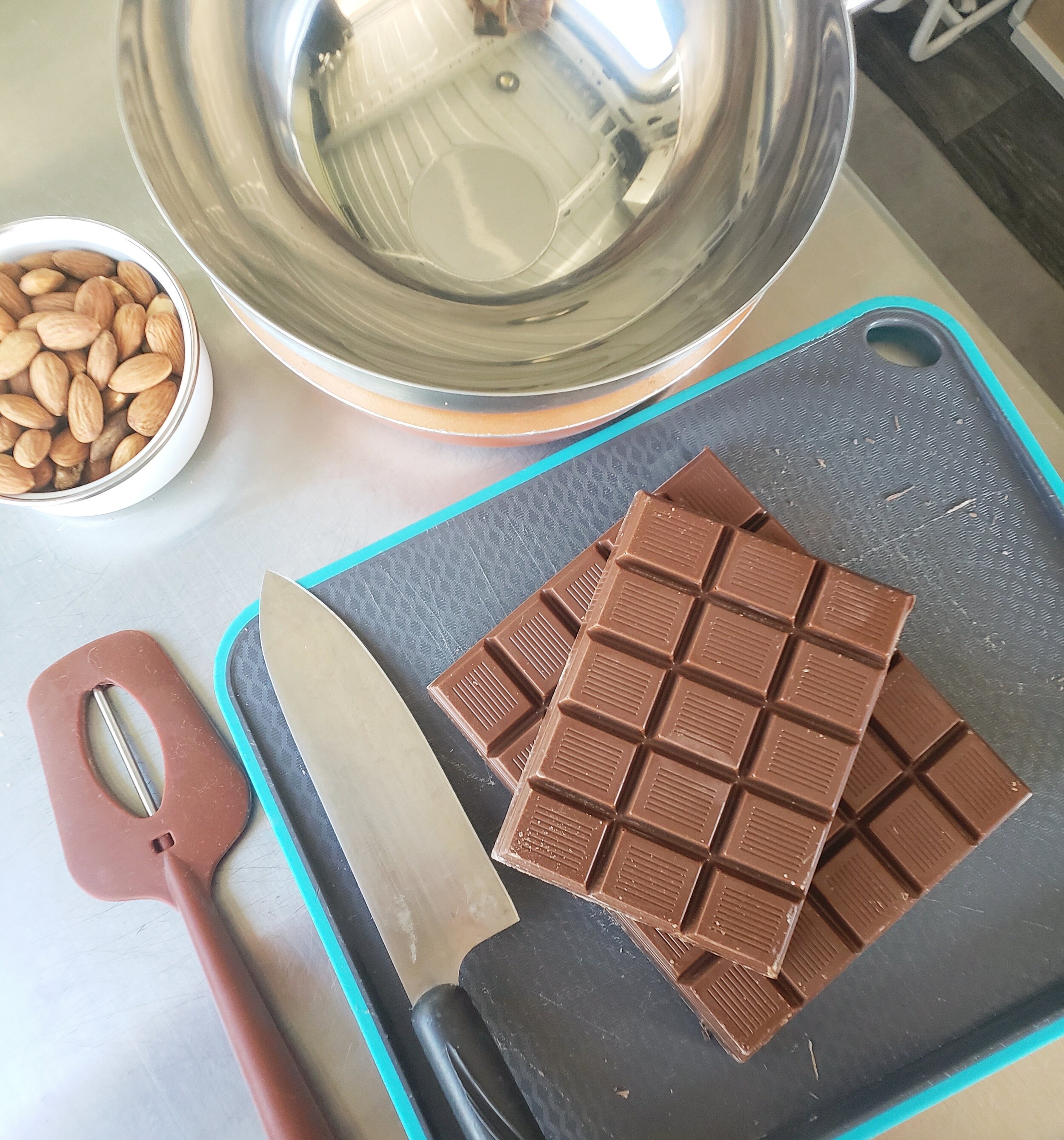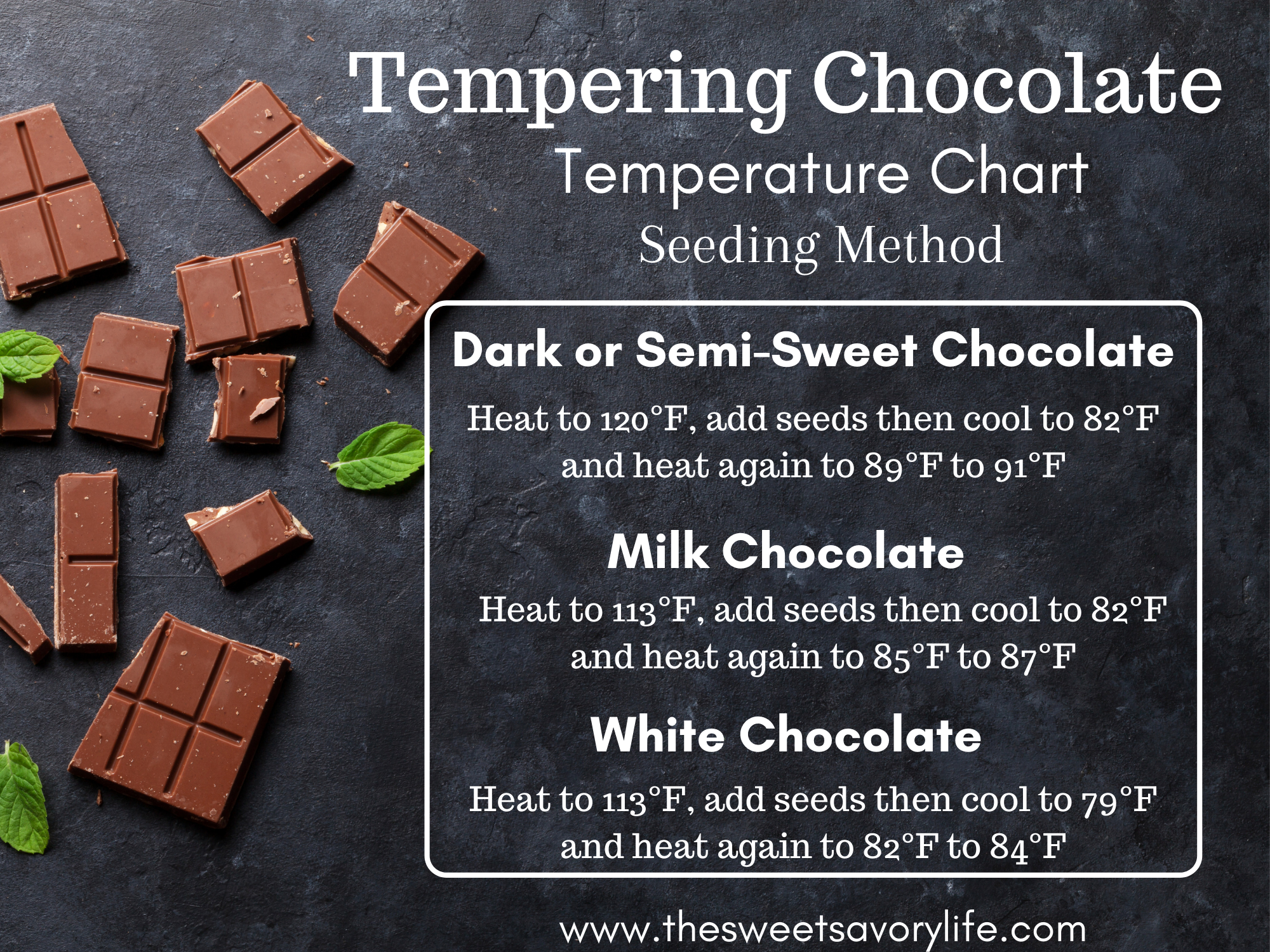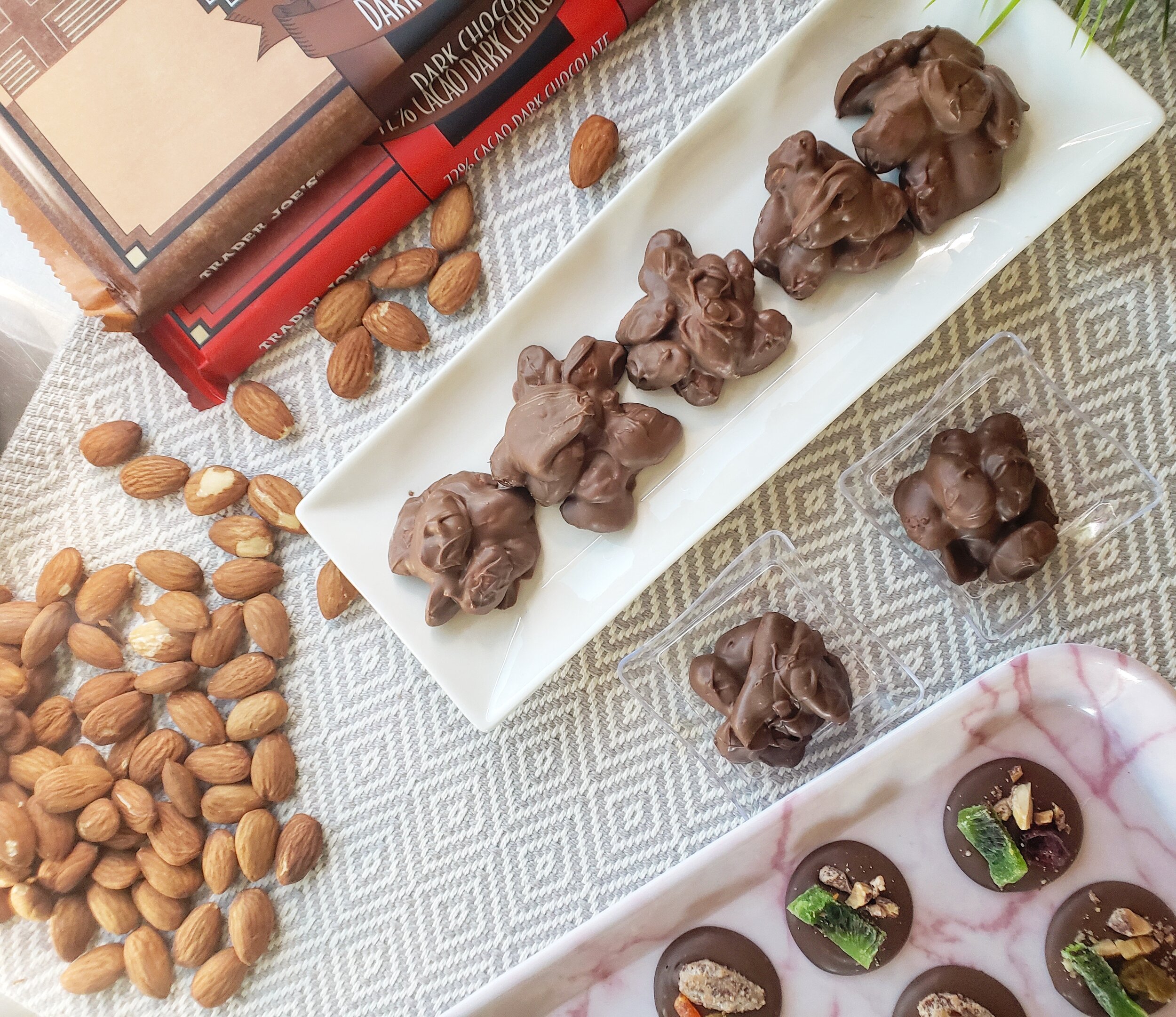Chocolate Almond Clusters Recipe
This post contains affiliate links.
Chocolate Almond Clusters Recipe | The Sweet Savory Life
Among my favorite chocolate confections are almond clusters! I love the pairing of chocolate and crunchy roasted almonds, a classic chocolate treat! Although most of the time I prefer the salted dark chocolate version, lately I’ve been craving anything milk chocolate. So for this super simple, 2-ingredient recipe, I used milk chocolate. Keep in mind that the choice of chocolate to use depends on your preference.
Making these chocolate almond clusters are as easy as 2 steps. First, temper the chocolate. Then mix in the almonds and scoop into clusters. Really, it’s that simple! The biggest trick is learning how to temper the chocolate properly.
Chocolate Almond Clusters Recipe | The Sweet Savory Life
What chocolate to use?
Not all chocolates are created equal. Some are best for baking while others for coating. For almond clusters, we will need to use real chocolate which contains cocoa butter. Most good-quality chocolate bar you can find at the grocery store has cocoa butter in them. A few popular baking brands of chocolate wafers like Guittard are also great options. Just pay attention to the label. For this recipe, I used the “Pound Plus Milk Chocolate” from Trader Joe’s. Baking chocolate chips are unfortunately not ideal for coating and enrobing because they use other fats such as vegetable oil instead of cocoa butter.
Options: milk chocolate, dark chocolate, semi-sweet chocolate, 72% chocolate (choose the one you enjoy most)
Chocolate Almond Clusters Recipe | The Sweet Savory Life
Compound vs Real Chocolate
Chocolate couverture or real chocolate contains cocoa butter and is best to use for coating. The proverbial “melts in your mouth, not in your hands” stems from the fact that cocoa butter melts at body temperature. Melting real chocolate alters its molecular structure resulting in a dull and chewy mass once cooled. To help the chocolate restructure its molecules back to their original state, tempering is required. Tempered chocolate hardens with a snap and gloss once cooled, just like how it was before melting.
Compound chocolate, on the other hand, is made from lesser quality cacao beans with other forms of fat like vegetable shortening and sugar. Compound chocolate is much cheaper and is often used as an alternative to real chocolate in baking and enrobing.
Read more about how chocolate in my bean-to-bar blog here.
Here are other options of chocolate to use for coating:
Guittard semi-sweet chocolate wafers (Also, available at Winco Bulk Section)
Trader Joe’s “Pound Plus” block of chocolate (Available in milk chocolate, dark chocolate, and 72% dark chocolate)
most bean-to-bar chocolate or your favorite bar with cocoa butter content
How to temper chocolate?
My preferred method in tempering chocolate is the seeding method using the double boiler. You can also use the microwave to temper your chocolate. Read more about how to temper here.
Note: a thermometer is a must in tempering chocolate. I love using this thermometer spatula for ease of use.
Chocolate Almond Clusters Recipe | The Sweet Savory Life
Double Boiler Seeding Method
Equipment: double boiler or pot, glass or metal bowls, thermometer, spatula (or thermometer spatula), a small piece of parchment paper, towel
Finely chop or shave the chocolate to help melt them faster without using excess heat.
Fill 1/4 of the pot with water making sure it doesn’t touch the base of the bowl.
Place 2/3 of the chopped chocolate into a glass or metal bowl and place it on the top of the pot at low heat.
Do NOT boil the water, turn it off once it starts to simmer.
Mix until all lumps are melted making sure that the chocolate temperature does not exceed 113°F. I usually take it out of the heat at around 110°F since the bowl retains some heat. (The temperature is for milk chocolate, refer to the chart below if using dark chocolate).
Take the bowl out of the pot and dry with a towel.
Add half of the remaining chopped chocolate (aka seeds) into the melted chocolate until all lumps are melted; then add the rest of the remaining chopped chocolate and mix until melted.
Keep mixing lowering the temperature to 82°F. (refer to the chart below to get the right temperatures for the kind of chocolate being used)
Place the bowl back to a heated pot and heat the chocolate to the working temperature of 85°F to 87°F.
Before coating, make sure that the chocolate is tempered correctly by placing a thin coat in a small piece of parchment paper and place in the freezer for 3 minutes. It should come off the parchment paper easily with a gloss and snaps when broken in half.
Chocolate Temperature Chart:
Dark or Semi-Sweet Chocolate: heat to 120°F then cool to 82°F and heat again to 89°F to start coating.
Milk Chocolate: heat to 113°F then cool to 81°F and heat again to 86°F.
White Chocolate: heat to 113°F then cool to 79°F and heat again to 82°F.
How to Temper Chocolate - Temperature Chart | The Sweet Savory Life
Chocolate Almond Clusters Recipe
Equipment: parchment paper or a silicone mat, bowl, spatula, and spoon
Ingredients:
6 oz or 3/4 cup of tempered chocolate (add more as needed)
half-pound of roasted almonds
sea salt (optional)
Note: Using roasted almonds is a MUST! It gives a crunchier texture and tastes nuttier and less earthy. I bought a bag of unsalted roasted almonds from Trader Joe’s. If you only have raw almonds, simply place almonds in a pan and roast stove-top for 3 to 5 minutes until brown and fragrant. Allow the almonds to cool first before adding the chocolate.
If using a metal or glass bowl, slightly warm up the bowl either in the microwave or with hot water. This helps the chocolate maintain its temperature. Just make sure that the bowl is completely dry before using. Chocolate seizes with water. (see pro-tips below)
Place the parchment paper (or silicone mat) flat in a sheet pan or the counter.
Place the roasted almonds in the slightly warm bowl and pour in the tempered chocolate. Mix with a spatula until all almonds are coated evenly.
Scoop almonds into clusters in the parchment paper. I prefer smaller 2-bite sizes.
Sprinkle with sea salt. (optional)
Allow to completely cool off and dry before consuming.
Store in an airtight container at room temperature.
Chocolate Almond Clusters Recipe | The Sweet Savory Life
Pro-tips:
When I made my first test batch, I didn’t temper the bowl temperature which caused my chocolate to harden faster making it hard to scoop out. It is best to slightly warm up your bowl first before pouring in the chocolate and almond.
The same is true for the spoons and scoops you use to form the clusters. It is best to dip them in warm water and dry them completely before touching the chocolate.
The best working temperature depends on the chocolate you use. Refer to the chart. If the chocolate starts to harden, simply heat it back to a workable temperature.
You can use tempered chocolate to enrobe truffles. fruits, pretzels, and many more.
These clusters make an excellent homemade gift.
Chocolate Almond Clusters Recipe | The Sweet Savory Life
Chocolate Almond Clusters Recipe | The Sweet Savory Life
Chocolate Almond Clusters Recipe | The Sweet Savory Life








